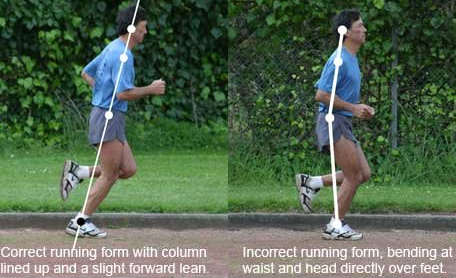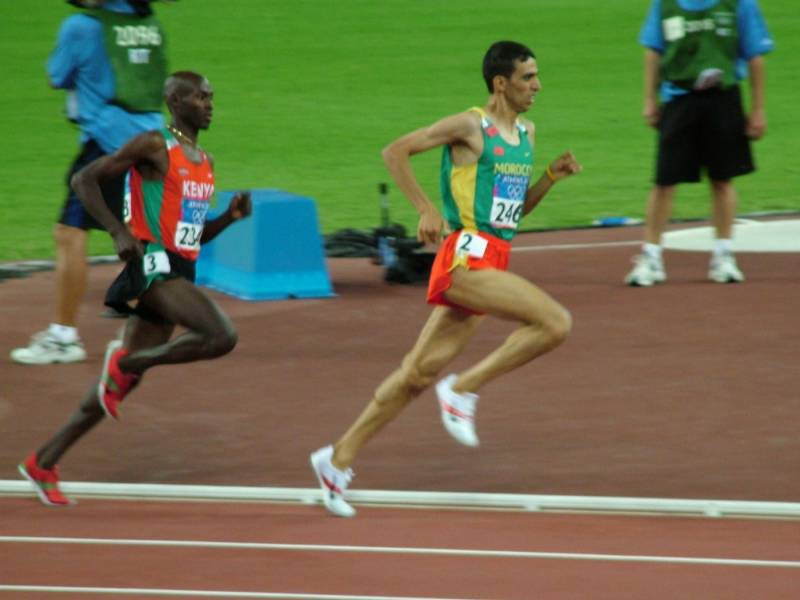Running form is a frequently discussed topic among injured runners and runners looking to perform better. How should we run? Is there one ideal way to run? Should we run on the forefoot, mid-foot or heel? Does our core matter? What should our upper body do when we run?
There are many schools of thought in the running world and there doesn’t seem to be any ironclad consensus on any of these questions. If you’re running pain-free and you’re performing as well as you’d like then I don’t believe you should change your running form. In other words, if it ain’t broke, don’t fix it.
If, on the other hand, you experience pain when you run or if you’re not as fast as you’d like to be then some technique changes may be in order.
Run tall.
A lot of us run in a hunched type of posture that resembles the way we sit (and sit and sit…) in our work chairs or in our cars. This hunched position may be problematic and may be contributing to running problems. To address this issue:
Imagine a chain is attached to the top of your skull. That chain pulls you up. It lengthens your spine and makes you tall. See if you can feel this long, tall spine as you run. As part of this process, keep your gaze up and out toward the horizon. Don’t stare at the ground directly in front of you. This tall posture should help with some of our other running form considerations.
Tight hip flexors may contribute to a hunched posture. The following stretch sequence may help.
Run light.
The impact of the foot hitting the ground is worth considering as it concerns injuries. Recent evidence suggests runners who hit the ground lightly are injured less than runners who hit the ground hard.
You may run with earphones and you may be unaware that you stomp and pound the ground with each footfall. So to run light, remove the earphones and pay attention to the sound you make.
Imagine you’re weightless. Your strides are feathery light, and energetic. You don’t pound the ground but rather you glide across gossamer.
Another way to run lightly comes through this skipping drill:
Use a short, quick gait.
One way to lighten the impact of running is to drop the foot very nearly under your hips. This should result in your shin being vertical or near-vertical. Look at the picture. Try running like #2. The skipping drill from above can help you feel that foot landing directly below your hips.
Don’t concern yourself with whether or not you’re hitting on the heel, mid-foot or forefoot. Where the foot lands is more important than on what part of the foot hits first.
Quickening your cadence too much can be a problem. There is an obvious point at which gait can becomes too quick and inefficient. An excellent way to work on your cadence is to use a metronome. Kinetic Revolution has a great article that discusses research on cadence as well as how to introduce metronome running into your training. The article also links to a digital metronome that you can download.
Change takes work.
Running may seem like something we should all be able to do. In fact, most of us can execute some version of movement in which we rapidly put one foot in front of the other. Kids learn to run without detailed instruction and without much in the way of typical running injuries. Shouldn’t adults be able to do the same thing? Maybe or maybe not… If we hurt while running or if we think we’re too slow, then some sort of alteration to our running style may make sense.
Changing your gait takes some tinkering, some awareness and mindfulness. It won’t happen automatically. Physical therapist Rick Olderman helped me to change my running gait. He once said that “if it feels normal, then you’re doing it wrong.” He meant that in the early stages of changing how we move, it should feel weird and unnatural to us. Learning any new skill requires some struggle and awkwardness. If you practice frequently and work at it then things should improve at a reasonable rate.
Personally, I never listen to music while running. I pay attention to how I run, where my foot falls, how I move. I don’t want to fall back into bad habits.
Finally
I can’t guarantee that any of these changes will result in either a pain-free running experience or a podium finish in a race.Time with a physical therapist, podiatrist, chiropractor and/or a running coach may be what you need. That said, these cues have helped my running as well as several of my clients’ running experience. I’ve also incorporated things like the short foot drill, ankle dorsiflexion work, and a wide variety of single-leg squats and lunges (here, here, here for instance) to improve my movement competence. Clearly, there are a lot of moving parts to consider when we run!






